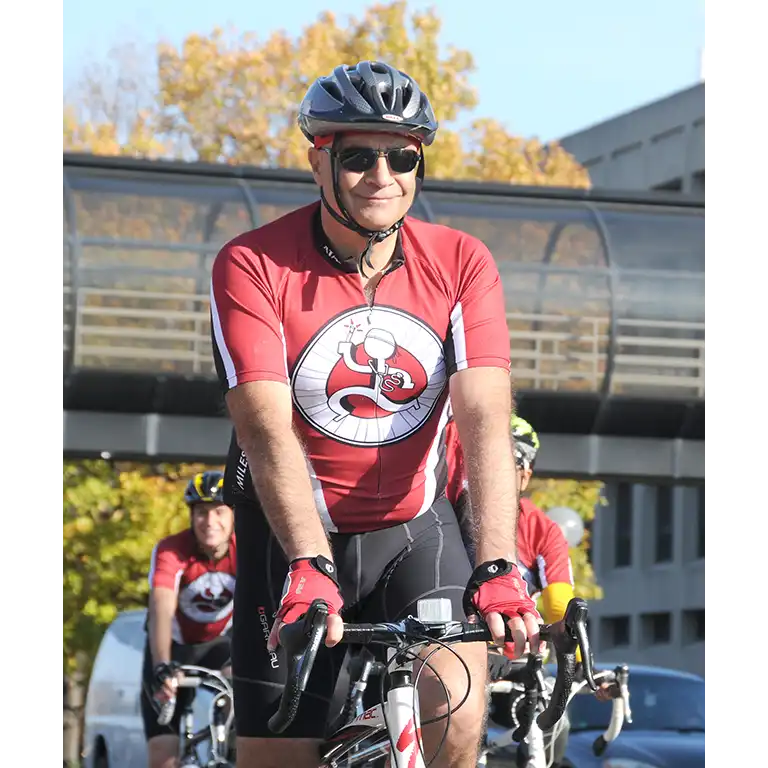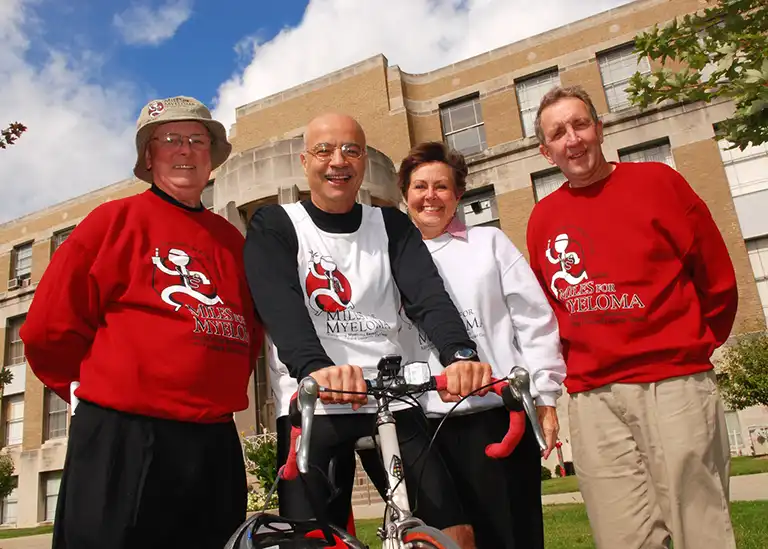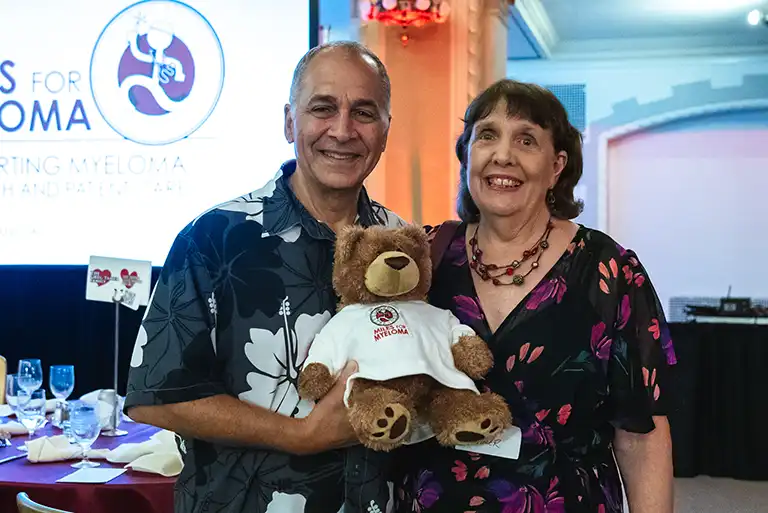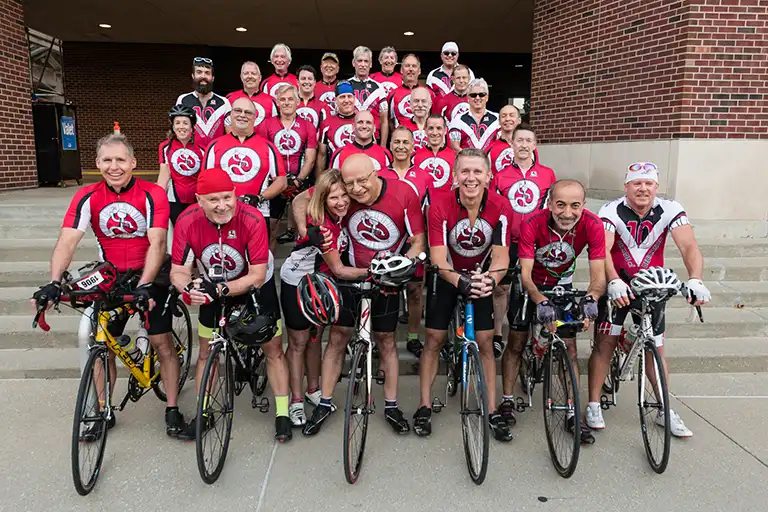Sept. 16, 2024
Celebrating a journey fueled by science, compassion and hope

It was 1984 in Syria and a young Rafat Abonour was preparing to graduate from medical school. One of the requirements he needed to complete was writing a book about something exciting happening in medicine. He chose the use of immunotherapy in cancer treatment as his topic. “It seemed like fiction at the time,” Dr. Abonour, who is now the Harry and Edith Gladstein Professor of Cancer Research at Indiana University, said.
Fast forward to 2024, and immunotherapy is being used successfully to treat a wide variety of diseases — including lymphoma and, yes, multiple myeloma. Being unafraid to look at what could be rather than being satisfied with what is has been a defining characteristic of Abonour throughout his entire professional career. “I don’t believe in the status quo,” he said. “You have to always be curious and look for answers.” Finding answers for his patients is what fueled his desire to launch Miles for Myeloma (M4M) in 2005 as an annual event dedicated to increasing awareness of multiple myeloma and raising funds to support research into treatments for the disease at IU.
Celebrating 20 years of progress
At the 20th annual Miles for Myeloma Patient Education Symposium on Sept. 22, patients, families, supporters and physician-scientists came together to celebrate the myeloma program at the IU Simon Comprehensive Cancer Center.
Starting with Dr. Abonour’s “Why”
The science of multiple myeloma — including understanding how it works and observing the limitations of treatments — is one of the key factors that sparked Abonour’s interest in the disease. “Curiosity is so important in this field,” he explained. “You have to always be asking ‘why’. Why do some patients experience longer remissions than others? Why does multiple myeloma develop in one person but not another? Why do some treatments work and others don’t? Why is this patient responding better to a specific therapy? These are the types of questions we’re constantly investigating.”
In addition to his interest in the science of multiple myeloma, the other “why” for Abonour is his patients. Treating individuals who have an incurable disease — such as those with multiple myeloma — comes with its challenges. But, according to Abonour, it also comes with some unique opportunities.
“Because it isn’t possible for me to cure my patients — yet — they often stay with me for long periods of time,” he said. “This gives me the chance to really get to know them and their loved ones. They become like family.”
Abonour, who is known for his compassion and his desire to listen, has shared many journeys with his patients over the years. “They’re all unique,” he explained. “For example, with some of the younger patients, there’s often the question of whether they’ll live long enough to have kids. My response is that I have patients who have had children, who have climbed Mt. Kilimanjaro, who didn’t just walk their child down the aisle but also lived long enough to experience the joy of grandchildren. Patients with myeloma are living longer and their quality of life is improving. They’re not only able to enjoy the simple things, but also fulfill big dreams — like taking a European cruise. They get to experience important milestones.”
Treatments for multiple myeloma have increased and improved significantly, as well as rapidly. “In just the past 20 years, almost 15 new drugs have been approved,” Abonour said. These advancements are made possible by research being done in laboratories around the world — including those at IU.
“We’re blessed here at Indiana University to be able to provide high quality care to our patients,” Dr. Abonour said. However, this wouldn’t be possible without adequate funding.

Hitting the road for multiple myeloma
Two decades ago, Dr. Abonour was sitting with some of his patients. As they were talking, they began to discuss ideas about how they could increase awareness of multiple myeloma and also raise funding for the research being done at IU.
“Because I was really into running at the time — including participating in marathons — one of my patients suggested that we do a 5k run,” Abonour said. “But there are already so many of them and we didn’t want to be just one more. I started thinking about how so many of my patients come from all over the state — traveling long distances — to come see me for a second opinion. So, I suggested that I run to their towns as a way to raise both awareness and funds.” This is how M4M came to be.
“The patients organized everything, including routes, support, police escorts and all of the other details,” he added.
On Oct. 1, 2005, the first day of the first M4M event got underway. Participants would be traveling from Indianapolis to Fort Wayne — covering the distance in two days. Because there was limited time to cross the almost 150 miles between the two cities, the decision was made to bike the first day and run the second.
“It was a beautiful day for our start,” Abonour recalled. “Patients, colleagues, friends, family and IUPUI Jaguar cheerleaders gave us a rousing send-off. Our initial group consisted of nine riders, two of whom were patients with multiple myeloma. We rode from Indianapolis to Marion that day, covering a little over 60 miles. Along the way, we stopped in Elwood where a large crowd of patients and their families were there to greet us. While we were there, the mayor handed us both a personal check from his own account and money collected from the town — all to support our research efforts.”
Police escorts guided the group through different sections of the route and an RV carrying a support crew followed.
The inaugural M4M event was a huge success, raising $125,000 for multiple myeloma research at IU. “While we do receive grants and other types of funding for our research, it’s limited,” Abonour explained. “Also, there are often specific parameters around how these funds must be used. However, with the money we raise through philanthropic efforts — such as M4M —we have the freedom to think outside of the box and ask bigger questions.”
Keeping research running

“Miles for Myeloma is very important for multiple myeloma research at IU because it provides funds for pilot studies to explore new research avenues that otherwise would not be possible,” Brian Walker, PhD, the Daniel and Lori Efroymson Professor of Oncology at IU School of Medicine, said. “These pilot funds can lead to discoveries that are used in bigger funding applications to foundations such as the Leukemia & Lymphoma Society or the National Cancer Institute. Also, Miles for Myeloma provides funds to support biobanking of patient samples.” The importance of these samples can’t be overstated. According to Walker, they play a key role in helping to “identify mechanisms of drug resistance and develop new models to test new therapies.”

Recognition of the significant impact funding from M4M has had is shared by Attaya Suvannasankha, MD, the Carol J. Edwards Professor and associate professor of clinical medicine at IU School of Medicine. “Miles for Myeloma has been a game-changer for multiple myeloma research at IU,” she said. “It’s allowed us to dive into cutting-edge projects and explore new treatment options that might not have been possible otherwise. They’ve also helped kickstart clinical trials and advance our understanding of the disease, which ultimately benefits the patients we care for.”
Expanding the reach of M4M
Navigating the emotional, physical, economic and social challenges associated with multiple myeloma is something patients shouldn’t do alone. This is why funds generated by M4M now go to both research and enhanced patient care.
There are a variety of ways the patient care experience has been elevated by M4M, including the following:
- Patient navigators help guide patients through logistics related to treatment — such as providing patients directions to clinic locations, scheduling appointments, letting patients know what they need to bring with them to their appointments, and explaining what to expect when they begin treatment.
- Clinical team members help patients develop a better understanding of multiple myeloma, as well as treatment options and potential outcomes.
- Funding from M4M makes it possible for IU to help patients and their families offset the cost of basic needs — including parking, mileage and housing.
- A monthly myeloma support group is offered through IU Health’s CompleteLife program
Treating multiple myeloma requires a holistic approach to patient care. By providing funding to support both research and the patient experience, M4M is ensuring patients are surrounded by the care, support and compassion they need at every point of their treatment journey.
The power of patient partnerships
When he was diagnosed with multiple myeloma in 2015, Greg Tamer literally passed out on the examination table. In his mind, he knew what such a diagnosis meant because his father died from multiple myeloma in 1961. “I was six years old at the time, so I really don’t have that many memories of my dad,” Greg said. “When I was diagnosed, I was scared my grandchildren wouldn’t remember me. I felt like I wouldn’t be here to see them graduate. And I was also worried about my wife, Jan. I didn’t want to leave her all alone.”
What Greg didn’t realize at the time was how much the understanding of multiple myeloma has increased and how far treatments have advanced since 1961. Because of the research being done by scientists at IU and others, Greg’s journey would look very different than his dad’s.
As part of his treatment regimen, Greg had two stem cell transplants. “When I had my second one, this tall dude with cool glasses walked in,” he said. “That’s the first time I met Dr. Abonour. We started talking about biking — which was something we both loved to do — and I’ve been his patient ever since.”
By 2016, Greg was feeling healthy enough to participate in his first M4M ride. And he’s been involved every year since then. Although the biking portion of the event hasn’t been included since 2020, Greg has kept a version of it going. “I send out emails inviting people to participate in any of four 50-mile rides that are held on separate weekends and in different locations,” he explained. “Many of us wear our M4M shirts when we ride, and we’ve raised at least $35,000 since we started in 2017. Also, my grandson, who lives in Minnesota, put together a 5k run for multiple myeloma and raised $2,000 with that. So, raising money for multiple myeloma research is a priority in our family.”

Greg’s wife, Jan, has been a committed partner throughout Greg’s treatment journey and in his fundraising efforts. Together, they participate in the M4M annual gathering — which includes an auction for the opportunity to have Miles the Bear become an honorary family member for a year. The pair have submitted the winning bid multiple times and when Myla the Bear was added to the mix in 2023, they also won the bidding war for her. “This year, they’ll both go up for auction,” Greg said. “We won’t bid on them this time. Instead, Jan and I will match the winning bid.”
Greg has felt the impact M4M has had on myeloma research and patient care. “When I was diagnosed, Jan and I had been married for 40 years,” he said. “I didn’t think I’d make it to our 41st. But now, I’m planning for our 50th!”
A legacy that’s still being created
Ultimately, the goal of M4M is to help fund research that will lead to a cure. But until then, the event will roll on. “I promised patients that as long as multiple myeloma is an incurable disease, Miles for Myeloma will continue,” Abonour said.
“What I want Miles for Myeloma to represent is the resilience of people when they’re faced with adversity,” Abonour said. “This resilience translates to a better quality of life. And, when people join forces to face adversity together, better outcomes can be achieved.”
Although the legacy of M4M is still being built, the first 20 years have shown what’s possible through collaboration and mutual respect. “There are a lot of things we have in common as human beings,” Abonour said. “With Miles for Myeloma, we’ve proven that we can share a common cause or mission and work together so beautifully. I wish this could be translated into how human beings interact with each other no matter where they are or what their differences might be.”
Abonour’s own legacy is also still being written. The impact he has had and continues to have on his team and his patients is irrefutable.
“Dr. Abonour is a joy to work with,” Walker said. “I couldn’t imagine the IU myeloma team without him. He is incredibly supportive of our research and the myeloma team as a whole. He provides important insight into the clinical benefit of our research to his patients, so that we remain focused on what is important.”

For many members of his team, Abonour is both a colleague and a mentor. This has certainly been the case for Suvannasankha. “His passion for both patient care and research is contagious — and he’s created an environment where innovation and collaboration thrive,” she said. “I’ve learned so much from him, and I’m grateful to be part of a team that shares his commitment to making a real difference in the fight against myeloma.”
But perhaps the most important and lasting part of Abonour’s legacy will be the hope, compassion and care he brings to his patients and those they love. “His attitude is so optimistic,” Jan Tamer said. “Greg and I have confidence in his vision — and his approach to treating multiple myeloma is so upbeat. You can’t feel down when you’re around him.”
Greg has been a beneficiary of Abonour’s dedication to patient care. “When I was first diagnosed, I thought of the things I wouldn’t live to see,” he said. “But now I’m seeing those things and loving it.”
Since its inaugural event in 2005, M4M has raised $8.3 million — all of which goes directly to research at IU and enhanced patient care at IU Health. This funding is helping advance the research that’s leading to more effective treatments and that’s giving patients a very real sense of hope. As it enters its third decade, M4M will continue to make myeloma history by playing a key role in pushing the boundaries of multiple myeloma research — bringing us ever closer to a world in which this disease is no longer incurable.




